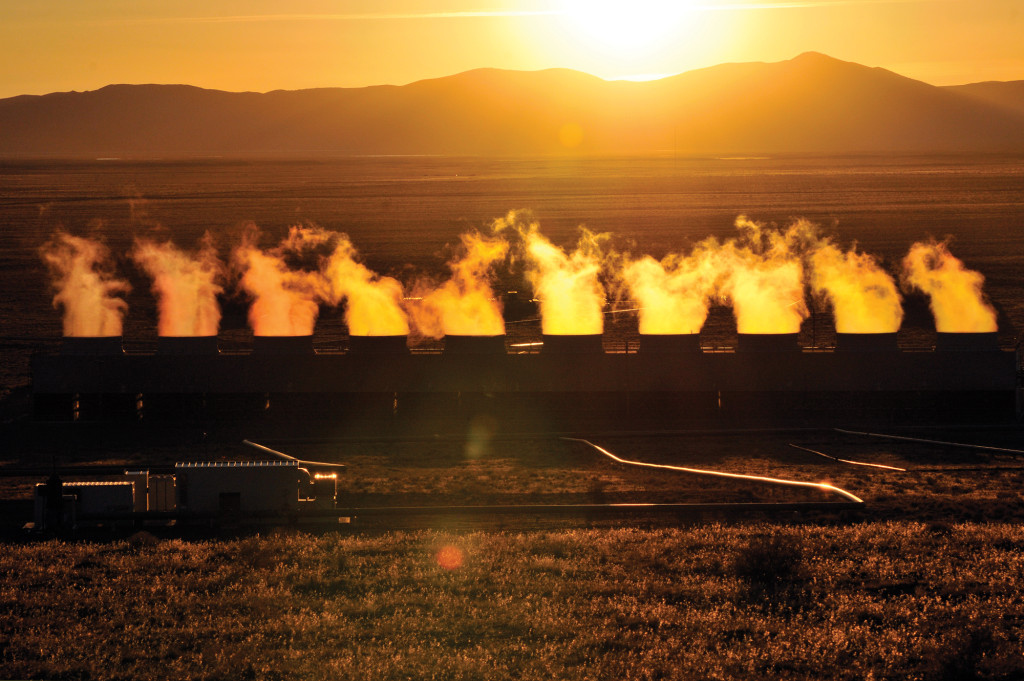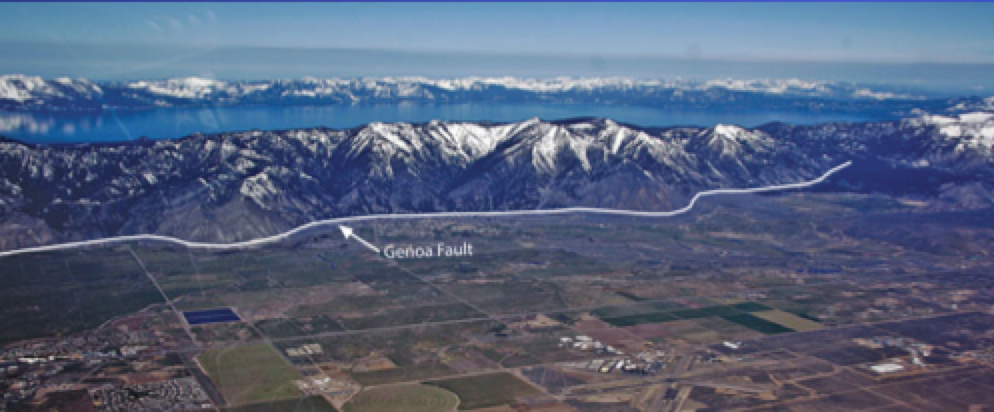Geological composition has Nev. on the move

Blue Mountain geothermal taps Nevada’s underground energy. Photo/Jack Hursh
By Linda Fine Conaboy
RENO – Nevada is the third most earthquake-prone state and is the fastest growing state, tectonically speaking, annually adding more area than the size of two basketball courts because of tectonic activity.
James Faulds, the state geologist for Nevada and director of the Nevada Bureaus of Mines and Geology at UNR, explained that Nevada has a greater number of mountain ranges, produces more gold, is volcanically active and has a vast supply of geothermal resources—more than any other state except for maybe Alaska.
According to Faulds, many of the state’s geothermal resources have yet to be discovered let alone mapped. This may explain, he said, why Nevada is always in hot water.
Earthquake faults, he said, allow hot water sitting deep in the earth to migrate to shallow levels, perhaps explaining why there are now close to 15 geothermal power plants in the state.
While their website states that Truckee Meadows Parks Foundation is in the business of transforming and maintaining the parks in Washoe County, the program they hosted in Reno last week went way beyond parks.
Three speakers covered all anyone needs to know about earthquakes, geothermal energy and volcanoes in Nevada. Though billed as a local event, all three speakers acknowledged that the Lake Tahoe Basin should be included in this mix, especially when the talk turns to earthquakes and volcanoes.
Although their intention was to inform and not to scare, many in the audience went away muttering about getting ahold of their agents pronto to chat about earthquake insurance. It was apparent that more than a handful were not aware that the Reno and Tahoe areas are seismically active and in fact, lie on some fairly large faults.

The Genoa fault is one of many near Lake Tahoe. Photo/Provided
Geothermal energy is the only renewable energy that’s available 24/7, and the potential for large amounts of energy production in Nevada is eclipsed only by California’s generation rates, according to the Natural Resources Defense Council.
Annie Kell is the coordinator of education and outreach and a professor of seismology, among other duties, at UNR’s Mackay School of Earth Sciences and Engineering.
She said Reno averages at least six earthquakes of significant size about every 12 years.
“There are thousands of structures in Reno that would be damaged in an earthquake,” she said.
Generally, Kell said, anything built prior to 1974 is vulnerable. The average cost to upgrade the deficits in these buildings she estimates at less than $5,000.
Kell said there’s a significant fault in Incline Village, which about 500 years ago produced close to a magnitude 7 quake. She also mentioned the West Tahoe fault zone running from Meyers to Dollar Point and submerged from Emerald Bay to McKinney Bay. Another fault, she said, lies near Stateline Point laying below the Club Cal Neva, and the Genoa fault, one of the most active, could threaten the Reno-Carson urban corridor.
Most people have heard stories of a potential tsunami able to inflict huge amounts of destruction to the Lake Tahoe Basin—Kell doesn’t totally rule out the likelihood, nor does Faulds.
“A tsunami is definitely a possibility,” Faulds said. “Research shows that in the past there have been tsunami events at Lake Tahoe—probably within the last 10,000-12,000 years, which is fairly young in terms of scientific research.”
Kell strongly urged the audience to prepare now for the chance of some major earthquake damage to the entire region, saying earthquake insurance in this area of the country is definitely worth it.
She’s a proponent of being ready even though there is no evidence that an earthquake is imminent. “An emergency survival kit can be a lifesaver,” she said, suggesting it should include:
· Food for three days
· Pet food
· Medical supplies
· A power supply
· Plan for evacuating the family
· Securing tall and heavy items.
In case of an earthquake, Kell advised, you should always protect your head and neck. “Drop, cover and hold on,” she said. “Do not run outside, stand near windows, get on top of furniture, get out of bed, drive over bridges, light a flame or run to a doorway.”
She added that during an earthquake event, aftershocks are a real possibility.
While he’s a professional geologist, volcanoes are an area of expertise for Christopher Henry, a research geologist at the Nevada Bureau of Mines and Geology.
Henry suggested that geology doesn’t follow state boundaries, but he said good volcano sites that are not too far away and easily viewed are Lassen Peak, Sutter Buttes (on private property) and Long Valley, adjacent to Mammoth Mountain.
In addition, he said there are numerous volcano sites between Reno and Lake Tahoe, particularly north of Tahoe near Truckee. These include Mt. Disney, Squaw Peak, Martis Peak and Mt. Pluto. He added that at Dollar Point, if you look hard enough, you can find layered and ashy areas that might include volcanic bombs.
Going south, to Mammoth and Long Valley, there are huge volcanoes, what Henry called super volcanoes that created a caldera 20 miles across. He surmised this event happened about 760,000 years ago, leaving today’s Mammoth Mountain.
In the last 600,000 years, smaller eruptions have taken place and in their wake, various craters can be seen, one of which is Mono Crater. “There are all kinds of volcanic pieces to be found at the sites. But then, all rocks are pretty to me,” he grinned.
Despite what may be construed as continuous danger, scientists predict that the chance of a magnitude 7 quake under Lake Tahoe are slim—about 3 to 4 percent in the next 50 years, and actually posing less of a threat than the potential danger from forest fires or floods. However, all the experts advise to be prepared.


